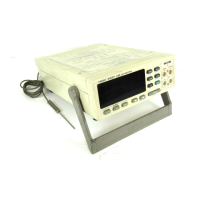115
────────────────────────────────────────────────────
8.8 Notes on GP-IB Interface
────────────────────────────────────────────────────
Symptom Cause/Treatment
The GP-IB has stopped working
completely.
Are the cables properly connected?
Is the device address for the 3227 set correctly?
Do some other devices have the same GP-IB address?
Are all the devices powered on?
After transmission on the GP-IB bus,
the keys on the 3227 freeze up and
have no effect.
Press the LOCK key on the 3227 (local key) to release the
remote state.
Has a LLO (Local Lock Out) command been transmitted?
Transmit a GTL (Go To Local) command to put the 3227 into
the local state.
When attempting to read data using a
Basic INPUT@ statement, the GP-IB
bus hangs.
Be sure to transmit one query before each INPUT@ (ENTER)
statement.
Have any of these transmitted queries resulted in an error?
Although a command has been
transmitted, nothing has happened.
Using *ESR? command, inspect the contents of the standard
event status register, and check what type of error has occurred
Sending several queries, produce only
one response.
Has an error occurred?
Read the response whenever transmitting each query. When you
want to read them in all at once, try putting them all on one
line using the message separator.
Have *IDN query been used?
The service requests are not
generated sometimes.
Have the service request enable register and the standard even
status enable register been set correctly?
Clear the standard event register at the end of RQS processing
subroutines with *CLS command. Unless the bit of the event
has been cleared once, no service request would have generated
in the same event.
The response message to a query
differs from the display of the 3227.
The response message is produced at the instant that the 3227
receives the query, and there is a possibility that it may not
agree with the display.
.8 Notes on GP-IB Interface
If the GP-IB appears to be malfunctioning, refer to the information below
before calling for servicing.

